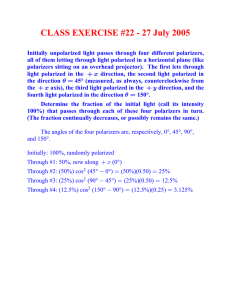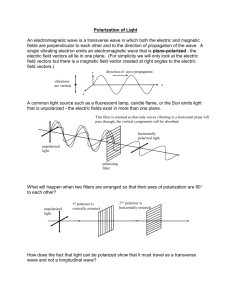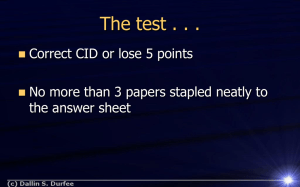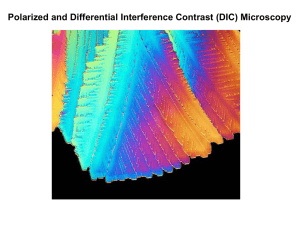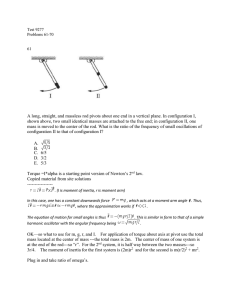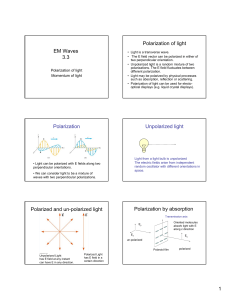PFC/JA-86-47 J.S. July 198 of
advertisement
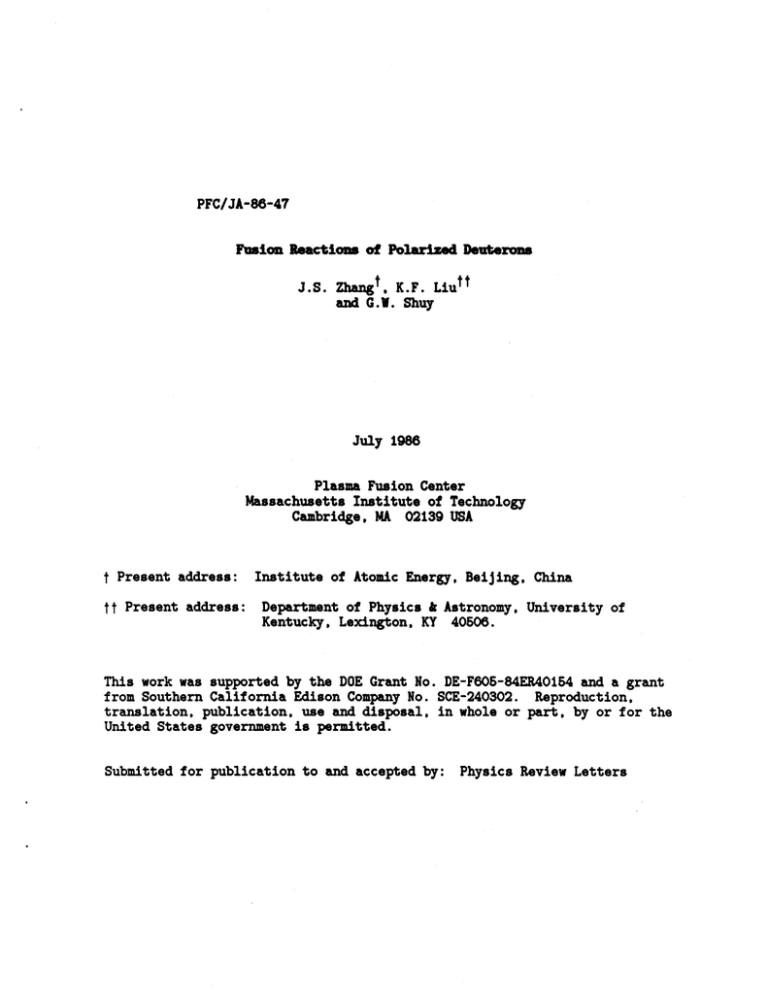
PFC/JA-86-47 Fusion Reactions of Polarized Deuterons J.S. Zhangt. K.F. Liu t t and G.V. Shuy July 198 Plasma Fusion Center Massachusetts Institute of Technology Cambridge, MA 02139 USA t Present address: ti Present address: Institute of Atomic Energy, Beijing, China Department of Physics k Astronomy. University of Kentucky, Lexington, KY 40506. This work was supported by the DOE Grant No. DE-F605-84ER40154 and a grant from Southern California Edison Company No. SCE-240302. Reproduction, translation, publication, use and disposal, in whole or part, by or for the United States government is permitted. Submitted for publication to and accepted by: Physics Review Letters Fusion Reactions of Polarized Deuterons J.S. Zhang+ and K.F. Liu Department of Physics & Astronomy University of Kentucky Lexington, KY 40806 G.W. Shuy Plasma Fusion Center, MIT Cambridge, MA 02139 Abstract Polarized and unpolarized d+d -+ n + 3 He fusion reaction cross sections in the center of mass energy region of 20-150 keV are calculated in a distorted wave Born approximation. The calculated unpolarized cross sections and the anisotropy of the angular distributions are within 20% of the experimental data. The polarized cross sections are found to be - 7.7% of the unpolarized ones despite the inclusion of the D-state component in 3 He. This shows that the idea of a "neutron lean" reactor may still be feasible. This result is consistent with the partial wave analysis of the tensor analyzing power in d(d.p)t reaction, but contrary to the findings of a recent resonating group calculation. + Present address: Institute of Atomic Energy, Beijing, China 2 It has been suggested1.2 that the spin degree of freedom in the plasma fusion reactions should be explored in light of the possibility that it could be utilized to enhance the desired fusion reaction rates and/or suppress the undesired reactions. 3 He(d,p) He reactions. 1 ,2 Examples are given for the t(dn) He. The cross sections of these reactions at low energies are largest at the J = 3/2+ resonances of the compound nuclei and 5 Li. 5 He At such low energies (i.e. 107 keV for the deuteron in d+t reaction and ~ 430 keV in the d+ 3He reaction), the reactions are predominated by the relative S-wave in the entrance channel. Thus the combined spins of the d+t and the d+ 3 He system are equal to 3/2 in these resonance reactions. Since the combined spins of d+t and d+3 He can be either a = 3/2 or a = 1/2, this shows that the a part in these resonance reactions essentially. 1/2 channels do not take Hence, upon polarizing the spins of the incoming nuclei in the parallel direction i.e., s = 3/2, these two reaction cross sections will be enhanced by It was further demonstrated 50%, a substantial gain. - that of the four mechanisms considered the depolarization rate is sufficient slower than the fusion reaction rate so that fusion reactors with polarized nuclei are feasible as far as the depolarization is concerned. An example for the simultaneous suppression of the undesired reaction is the polarized d(d,n) He (and 33 d(d,p)t) reaction which could admit the possibility of a "neutron-lean" fusion reactor . There is an experimental 3 evident of such suppression shown by the partial wave analysis of the tensor analyzing power in d(d. p)t reaction7 . The suppression is understood to occur when the deuterons are polarized in parallel (i.e., a - 2) so that at low energies where the relative S-wave dominates, the Pauli principle suppresses the two deuterons from approaching each other to initiate the reaction. In addition, since the total spin of the final state n + 3He can only be s = 1 or 0, the conservation of angular momentum and parity dictates that the exit channel must be in the relative D-wave which leads to additional suppression owing to the fact that this has to occur via the spin-orbit and tensor forces instead of the stronger central force. The latter example on the suppression of the polarized d+d reaction has raised a controversial issue. The argument for the suppression is based on the implicit assumption that the D-state probability in 3 He and deuteron are small and they do not contribute in any significant way. However, it is pointed out recently by Fick and Hofmann4 that the inclusion of the D-state probability in 3 He will allow the strong central force to contribute to the s=2 channel and could yield large cross section in the polarized d+d reaction. In their refinded resonating group calculation4 , they found that the polarized reaction is not suppressed at all. In fact, at E C.M.= 20 keV. the ratio of the polarized to unpolarized cross sections is around 1. seems to concur with the findings of the R-matrix analysis. This 5 Despite these results from the R-matrix analysis and the resonating group calculation, we think the problem deserves further critical 4 scrutiny 6 because these results contradict the partial wave analysis of the tensor analyzing power for d(dp)t at Ed = 290 keV.7 Furthermore, the central force contribution through the D-state probability in 3 He that Fick and Hofmann argued for is certainly allowed, but the magnitude of the matrix element in their calculation is inscrutably large. matrix element <3D2 , d channel and the <1 S D2 Vc 3 The reason that the S 2 > for the central force Vc between the 5S d2 D2 , D2 n 3He channel is smaller than the matrix element V | S > is related to the smaller internucleon D-wave component in the incoming d-d system in the relative S-wave6 ; a smaller D-wave projection for the central potential onto the relative coordinate between n and 3 8 He , and a number of cancellations upon antisymmetrization of the total wavefunction. The cancellation arises from the permutation symmetry upon antisymmetrization of the spin, isospin, and the spatial coordinates of the nucleons. This is quite transparent in the DWBA formalism where the antisymmetrization of the total wavefunction is treated analytically. On top of the above-mentioned reduction factors, the D-state probability in 3He is merely ~ 4%. Therefore, based on the above reasonings, we estimatede that the ratio of the polarized to the unpolarized cross section due to the central force should be 10 -3 -4 10-. This is 3 to 4 orders of magnitude smaller than that obtained in the recent resonating group calculation. 4 5 In order to verify our point quantitatively, we carried out a distorted wave Born approximation (DWBA) calculation. sections are of the order of ~ 10 mb , Since the d+d reaction cross they are more than two orders of magnitude smaller than the elastic d-d1 0 and n 3 He1 1 cross sections. This shows that the off-diagonal matrix elements in the coupled d-d and n 3 He channels are at least an order of magnitude smaller than the diagonal matrix elements. Therefore, the perturbative calculation such as DWBA should be reasonably good. The DWBA formalism has been adopted by Boersma 1 2 to study the dd reactions at these low energies. Contrary to what is implied in the Reply of Fick and Hofmann 13, there is no criticism to the suitability of DWBA for these reactions in Ref. 12. Instead, the success on the energy dependence of the cross sections is stressed and a more realistic dd wavefunction (which was not available at that time) beyond the Coulomb wavefunction used is called for improvement. The present work represents an attempt to answer this call for improvement. Effective potentials (including the folded Coulomb potential in the entrance channel) are used to generate the distorted waves between the d and d in the entrance channel and between the n and 3He in the exit channel. They are fitted to the d-d elastic scattering phase shifts given by D.R. Thompson 4 and the n 3He elastic cross sections. wave function (2G) D.R. Thompson The internal deuteron is taken from the work of F.S. Chwieroth, Y.C. Tang and and the 3He wave function from the work of B.R. Bransden. 6 H.H. Robertson. and P. Swan. 16 The same nucleon-nucleon interaction as used in the recent resonating group calculation4 (called S in Ref. 4) is employed to calculate the matrix elements in the Born approximation so that the results can be compared with those in Ref. 4. The unpolarized reaction cross section for the DWBA is written as: 2 [ 0 kw (2Sd+1)t c e2 3 3 2 D p + (2s+) }s1 with the polarized cross section Oao ( written as 2sl + D<3D2 . D2 Ic+VLS+VT 5 2 2D (2) where k is the relative wave number in the entrance channel in the C.M. system. PD is the D-state probability in 3 He which we take to be 4%. Vc' VL9S, and VT denote the central, the spin-orbit, and the tensor interactions respectively. The subscript D in Eq. (2) denotes the matrix elements for the D-state component in 3He. The normalization of the relative wave functions in the entrance and the exit channels include the _-" h 1/2 ad 4w2h2 hjs )1/2 412h2 7 factors respectively (p/p' and k/k' are the reduced mass and the relative wave number in the entrance/exit channel), so that the matrix elements are dimensionless. These matrix elements are calculated for the relative S and P waves in the entrance channel. The relative D wave is very small at these energies and is therefore neglected. The unpolarized cross sections and the anisotropy C2 /C0 in the angular distribution (dc/dO - C0 + C2 P2 (coso) + ... ) at 25 to 160 keV C.M. energies are plotted in Figs. 1 and 2 respectively together with the experimental data and the results from Fick and Hoffman.4 It is seen that our calculated unpolarized cross section and the angular anisotropy are generally within 20% of the experimental data in this energy region which justifies our approximation based on the DWBA calculation. It is worthwhile to point out that our results on the unpolarized cross sections represents an improvement over those in the resonating group calculation4 which are roughly a factor of 2 smaller than the measured cross sections. The results of the matrix elements (dimensionless) in different channels due to the various parts of the NN interaction are tabulated in Table 1 for the center of mass energies of the deuterons at 50, 100, and 150 keV. From Table 1 we have learned that the P-wave contribution constitutes ~ 4% of the total cross sections. Thus, it verifies that in this energy range the cross sections are indeed dominated by the S wave in the entrance channel. 8 The presence of the D-state component in 3He allows an a a 3/2 wave function in He which gives rise to an s a 2 matrix element by the central force. According to Table 1, its magnitude turns out to be an order of magnitude smaller than that of the S-wave, s = 0 matrix element due to the central force. This is attributed to a number of cancellations due to the permutation symmetry among the interacting nucleons upon antisymmetrization which involves large numbers and reflects the fact that the D-wave composition between nucleons in different incoming deuterons is smaller than the corresponding S-wave composition at these low energies. 4% for the D-state component in 3 He, Multiplied by ~ we predict that the central force yields polarized cross sections which are ~ 1.3 x 10 times of the unpolarized cross sections. in agreement with our earlier estimate. This is contradictory to the findings of the resonating group calculation which purports that the central force is responsible for their - 1:1 ratio of the polarized to the unpolarized cross sections. The spin-orbit and tensor forces, on the other hand, yield larger contributions to the polarized cross sections via the D-state component in 3 He (Table 1). since it Especially, the tensor force gives the largest contribution could connect a D-wave to an S-wave. However, according to our calculation, the combined central and these spin-dependent forces yield polarized cross sections which are - 7.7%of the unpolarized ones in this low energy region. This is certainly consistant with Ad'yasevich and Fomenko's analysis which predicted the polarized cross section to be about 9 5% of the unpolarized one at Ed = 290 keV. However, this is much smaller than those predicted by the resonating group calculation4 and the R-matrix analysis.5 The ratios of the polarized to unpolarized cross sections at low energies are plotted in Fig. 3 together with those given by Fick and Hofmann. 4 To further unravel the situation, we turn to the tensor analyzing powers which have certain bearings on the issue of the s=2 channel. It was pointed out in Ref. 4 that, without the s=2 channel contributing, the angular distributions of T20 and T2 2 (Azz and A ) should be symmetric with respect to 900 while those of T2 1 (Az) antisymmetric with respect to 900. The experimental results' 8 on the angular distributions of the tensor analyzing powers for the reaction d(a,n)3 He at Ed - 320 keV (160 keV in the center of the mass system) reveals that the angular distributions of T2 0 and T22 are rather symmetric with respect to 900 and those of T2 1 are quite antisymmetric with respect to 900. These are certainly contradictory to the implications of Fick and Hofmann in their article. 4 Results plotted on the contour diagrams at lower energies (Ed = 60, 80, 105, and 205 keV) 18 show that the asymmetries from the expected symmetries without the s=2 channel contribution are even smaller. This suggests that the s=2 channel is relatively unimportant at such low energies. 10 Combined with the experimental results on the tensor analyzing powers and our DWBA calculation, we feel that the polarized (s=2) cross sections may well be strongly supressed (at the 8-15% level) despite the presence of the D-state component in 3 He. Thus a "neutron lean" fusion reactor based on the suppression of the polarized d-d reactions may be attainable. However, more experimental data on the tensor analyzing powers and theoretical works involving the D-state component in the deuteron are still desired. This work is supported in part by a DOE grant No. DE-FGO5-84ER40154 and a grant from Southern California Edison Company No. SCE-240302. 11 REFERENCES Phys. Rev. 1. R.M. Kulsrud. H.P. Furth. E.V. Valeo and M. Goldhaber. Lett. 42. 1248 (1982). 2. S. Tamor, G.W. Shuy, and K.F. Liu, Bull. Am. (1982). 3. G.W. Shuy. A.E. Dabiri. Fusion Technology. 4. H.M. Hofmann and D. Fick, Phys. Rev. Lett, 52. 2038 (1984) 5. G.M. Hale, Proceedings of the Polarized-Fuel Reactor Workshop, Madison, Wisconsin, 1983, p. 11; G.M. Hale and G.D. Doolen, Los Alamos preprint LA-9971-MS. 6. K.F. Liu, J.S. Zhang, (1985). 7. B.P. Adyasevich and D.E. Fomenko, Sov J. Nucl. (1969). 8. The D-state probability in the deuteron is neglected in the present work. It is only ~ 7% in the deuteron and has been neglected in the calculations of Ref. 3. For the configuration that all the internucleon coordinates are S-waves in the dd system, three pairs of the central NN potential drops out due to orthogonality which leads to an additional reduction factor of 2 for the matrix involving this configuration. 9. H. Liskien and A. Paulsen, Nucl. Data Table 11, 569 (1973). 10. Balashko and Barit, JETP Z. 715 (1958). 11. A.R. Sayres, K.W. Jones. and C.S. Wu, Phys. Rev. 122. 1853 (1961). 12. H.J. Boersma, 13. D. Fick and H.M. Hofmann. Phys. Rev. Lett. fi, 1650 (1985). 14. D.R. Thompson, Nucl. Phys. LAW, 304 (1970). 15. F.S. Chwieroth, Y.C. Tang, and D.R. Thompson, Nucl. Phys. AIM , 1 (1972). 16. B.H. Bransden, H.M. Robertson, and P. Swan, Proc. Phys. Soc. LXIX, 12-A. 877 (1956). H. Gurol. and G.W. Phys. Soc. 2i, 922 Accepted for publication in Shuy, Phys. Rev. Lett. 5, 1649 Phys. 2. 167 Nucl. Phys. AM. 609 (1969). 12 17. H. Eikemsier and H.H. Hackenbroich, Nucl. Phys. LMI.2, 407 (1971). 18. B.P. Ad'yasevich, V.G. Antonenko. and D.E. Fomenko, Sov. J. Nucl. Phys. M, 313 (1981). Table 1 The DWBA matrix elements (dimensionless) in different channels at three different enegies due to the various parts of the NN interaction. Vc stands for the central force, spin-orbit force and VT the tensor force. subscript VL.S the Matrix elements with D are those with the D-state component in D-state probability is (the 4% not multiplied in these matrix elements). C.M. Energy (keV) 50 < 1 SOIVcI1 SO) 3 He 100 150 0.29x10-1 0.58x1&l0 0.86x10-1 0.31x10-2 0.63x10-2 0.94x10- 2 < 3 D2IVL.Sl 5 S2> 0.25x10- 2 0.49x10-2 0.74x10-2 < 3 D2,lD2VTI'5S2> 0.33x10-2 0.66x10-2 0.99x10-2 -0.12x10-2 -0.24x10-2 -0.36x10-2 0.61x10-2 0.12x10-1 0.18x10-1 -0.15x10- 1 -0.30x10-1 <3plVcl 3 P> D' 3 D2, 1 D2IVcI5 S2> D< 3 D2,lD2IVL-Sl 5 S2> D< 3 D2, 1 D 2 IVTI 5 S2> -0.45x10l- Figure Captions Fig. 1. The d(d,n) 3 He reaction cross sections as a function of the center of mass energy in the entrance channel. The dots are the experimental data. The solid line is from our DWBA calculation and the dashed line is from the resonating group calculation in Ref. 3. Fig. 2. The anisotropy C 2 /CO vs. the C.M. energy of the deuterons. The dots represent the experimental data. The solid line is our prediction and the dashed line is from Ref. 3. Fig. 3. The ratio of the polarized to unpolarized cross sections. The solid line is our prediction and the dashed line is from Ref. 3. I I I II I I I I jIl I i -o 0 0 0~ a) ~01 c 0 -o 0 0 0 0 I I I I II I II ~LL1 I l I i I 0 I I I I I I d (qLu)~o 0 a li~ I I I I I I I 0 I 01 - 0~ - to - - 0 0' - ci 0 Lo 0 I 0 I I II 1\ 0 0 0 OD/ Zo I I -'0 0 I IO 0 0 _I 0o~


